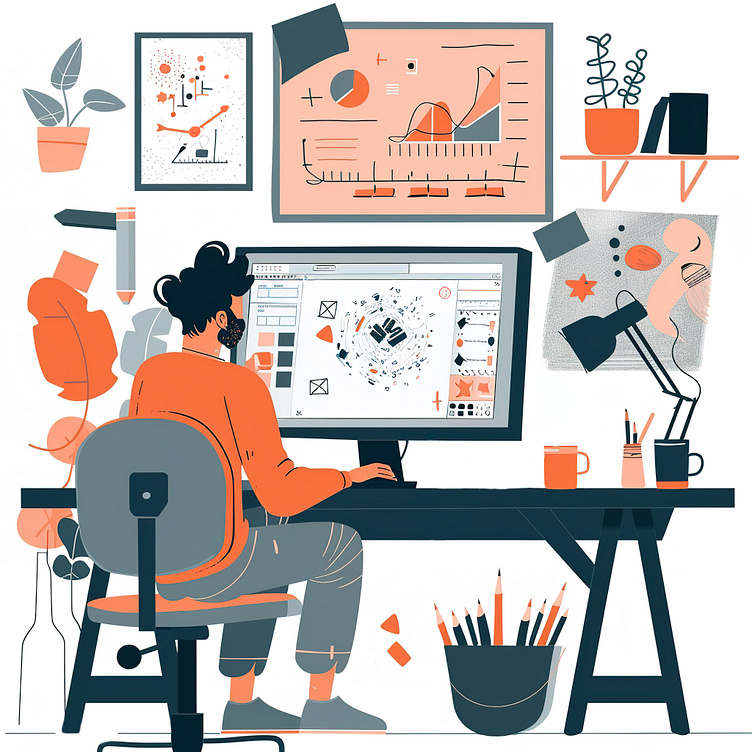Art of Illustrator Design Unleashing Creativity in the Digital
Adobe Illustrator, a cornerstone of graphic design, empowers artists and designers to bring their creative visions to life. As a vector graphics editor, Illustrator offers precision, flexibility, and a vast array of tools that make it indispensable for creating everything from logos to complex illustrations. This article delves into the nuances of Illustrator design, exploring its features, applications, and tips for mastering this powerful software.
Understanding Adobe Illustrator
Adobe Illustrator operates primarily with vector graphics, which use mathematical equations to create shapes. This allows for designs that are infinitely scalable without loss of quality, unlike raster graphics, which can become pixelated when resized. Illustrator's capabilities make it ideal for various design projects, including:
Logos and Branding: Creating scalable logos and brand elements that maintain clarity and quality at any size.
Illustrations: Crafting detailed illustrations for books, advertisements, and digital media.
Typography: Designing custom typefaces and manipulating text to create compelling typographic art.
Infographics: Developing clear and informative infographics that visually represent data and information.
Web Design: Creating web graphics and layouts that are crisp and responsive.
Key Features of Adobe Illustrator
Several features set Illustrator apart from other design tools:
Pen Tool: The cornerstone of vector design, the Pen Tool allows for precise creation of paths and shapes. Mastering this tool is crucial for detailed and accurate illustrations.
Artboards: Multiple artboards within a single document enable designers to work on various parts of a project simultaneously. This is particularly useful for creating multiple iterations of a design or for batch exporting.
Layering System: Layers help organize complex designs, making it easier to manage and edit different elements without affecting the overall composition.
Shape Builder Tool: This tool simplifies the process of combining, subtracting, and manipulating shapes, streamlining the workflow for creating complex designs.
Color Management: Illustrator’s extensive color tools, including gradients, swatches, and color guides, allow for precise color control and consistency across projects.
Brushes and Effects: Customizable brushes and effects enable designers to add texture, depth, and unique artistic touches to their work.
Tips for Mastering Illustrator Design
Learn Keyboard Shortcuts: Familiarizing yourself with Illustrator’s keyboard shortcuts can significantly speed up your workflow. Common shortcuts like Ctrl/Cmd + Z for undo and Ctrl/Cmd + G for grouping objects are essential.
Use Layers Wisely: Organize your work by using layers effectively. Naming layers and grouping related elements can make your projects more manageable and editable.
Experiment with Brushes: Explore the variety of brushes available in Illustrator. Custom brushes can add unique textures and styles to your illustrations.
Practice with the Pen Tool: Spend time mastering the Pen Tool, as it is vital for creating precise paths and shapes. Practice creating smooth curves and complex shapes to enhance your skills.
Utilize Symbols: Symbols allow you to reuse elements across your design. This is especially useful for maintaining consistency and making global changes quickly.
Explore Plugins and Extensions: Numerous plugins and extensions can expand Illustrator’s functionality. Tools like Astute Graphics provide advanced features for vector editing and design.
The Future of Illustrator Design
The field of Illustrator design is continually evolving, driven by technological advancements and changing design trends. Key future directions include:
Integration with AI: Adobe’s ongoing integration of artificial intelligence into its Creative Cloud suite, including Illustrator, promises to streamline workflows and introduce new design capabilities. AI-powered tools can assist in tasks like auto-coloring, pattern creation, and design suggestions.
Enhanced Collaboration: Cloud-based features are making it easier for designers to collaborate in real time, share assets, and maintain version control. This is particularly important for remote work and team-based projects.
Augmented Reality (AR) and Virtual Reality (VR): As AR and VR technologies become more prevalent, Illustrator is likely to incorporate tools for creating immersive and interactive designs for these mediums.
Sustainability in Design: There is a growing emphasis on sustainable design practices. Designers are increasingly considering the environmental impact of their work, leading to more eco-friendly design choices and practices.
Conclusion
Adobe Illustrator remains an essential tool for designers, offering unmatched versatility and precision in vector graphic creation. By mastering its features and staying abreast of emerging trends and technologies, designers can unlock their full creative potential. Whether you’re crafting a brand identity, illustrating a children’s book, or designing a website, Illustrator provides the tools needed to transform your vision into reality. As the digital landscape continues to evolve, so too will the possibilities within Illustrator, ensuring it remains at the forefront of graphic design innovation.

